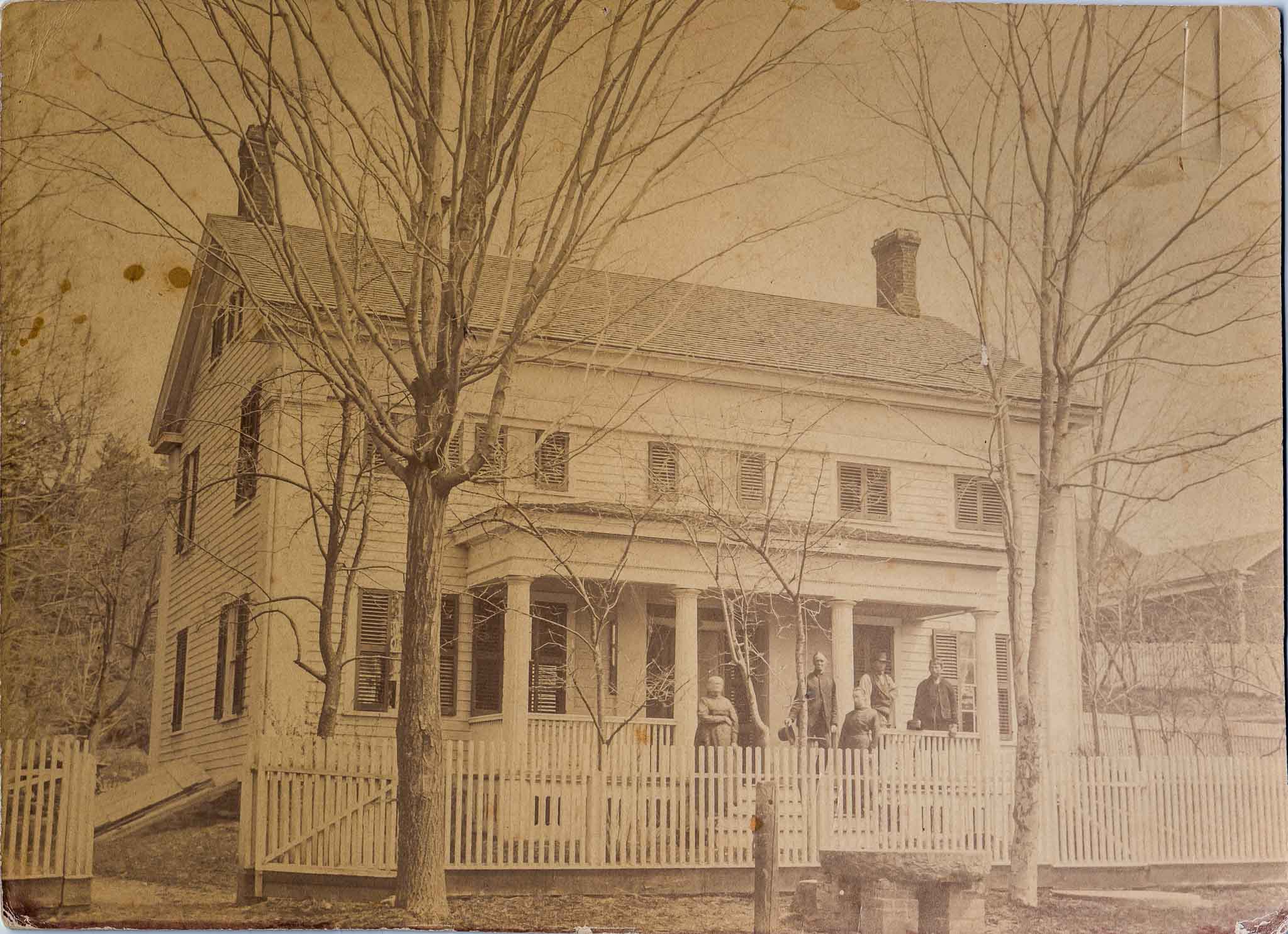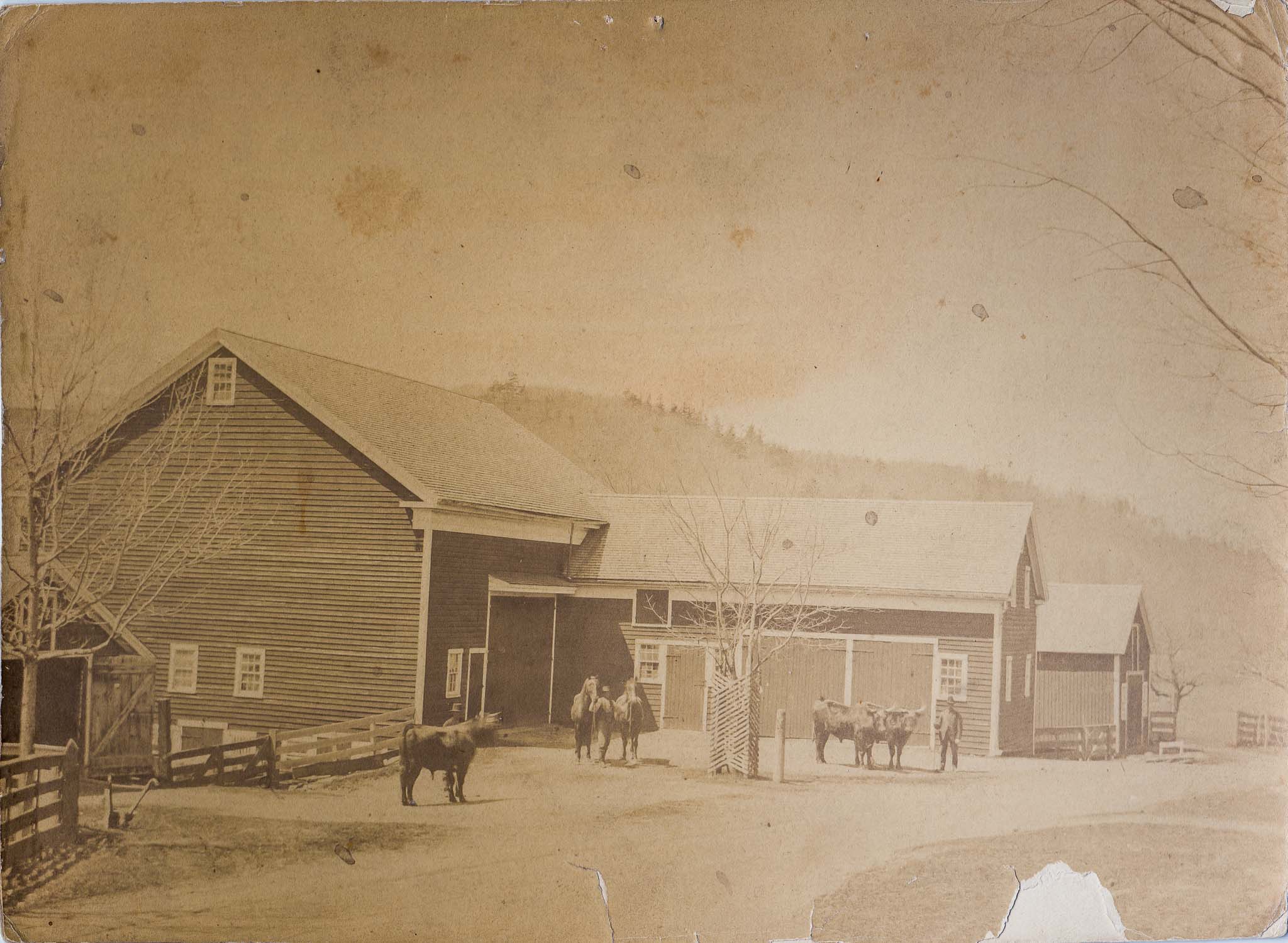Stewart Farm House and Barns
The Stewart House

The Stewart House
circa 1881 - 1891
More about the house later - this page is a work in progress. jhc
The Stewart Barns

The Stewart Barns
There were a lot of barns on the farm back in the day. Most were gone by the time Dad bought the place in 1945. All that remained were the big barn, the corn-house, and a small brick smokehouse. Oh, and the converted woodshed ("the little house") we lived in until he built the new house.
When Were They Built?
I spite of my long held belief they were built in 1868 based on that date carved into a beam in the scale room I think that's way off. Based on a few clues I'm now leaning to the mid 1830's.
Some Clues
A major clue: John & Albert Griswold borrowed $3,000.00 against the farm in 1834 and another $2,500.00 the following year. That's enough to build the whole shebang, I would think. They paid roughly that ($5,725.00) for the 210 acre farm 8 years earlier (with whatever buildings "old John Clark" had).
The house has the porch columns and faux corner columns found in farmhouses with some Greek Revival influence seen in early 19th century farmhouses in this area.
The barns were trimmed in a style common to this area by the first half of the 19th century (and for a long time thereafter).
The major barn framing was classic mortise and tenon pegged framing, hand hewn and used peeled logs with the upper side adzed flat for rafters. Peeled log rafters went out of fashion when sawmills came in and old growth timber was largely gone.
There wasn't much old growth timber left in the neighborhood by 1868.
There was a sawmill in Red Rock by 1868 and I think there was one here one the farm too but I don't know when, or how it was powered - steam engine maybe. There were a few remnants of it about the place. The main shaft and the blade (about 3ft) in the barn, and a huge lumber wagon axle I dug out of the gravel down by the crick. All date to before the turn of the century at the latest I think. The sawmill was here in 1915 - see below.
If memory serves, the framing braces and intermediate studs were rough-sawn on an up-and-down mill, not a rotary mill represented by the shaft and blade that were here.
The Corn-house (Corn Crib) Came Later
But before 1878 - it shows in Ellis' illustration.
It uses the classic mortise and tenon pegged framing.
It's framed with a mix of hand hewn timbers and sawn and planed braces and rafters and minor framing pieces.
When did a planer arrive in the area?
The loft joists are peeled logs adzed flat on top.
The few remaining loft floorboards are planed.
The vertical slat siding is planed.
The roof boards are waney-edged and planed.
The door boards are planed and beaded.
The first mention of a corn crib is recorded in a farmers almanac dating back to the year 1701. Corn cribs were rarely built on New England farms until the middle of the 19th Century, when growing 'Indian' corn became popular. Storing the corn on the cob in a well-ventilated corn crib allowed the kernels to dry without spoiling. The cobs were prized for use as oven ash that was used in smoking meats, as well as for quick kindling and numerous other purposes, making the need for corn cribs essential to the cultivators of the time.
From: https://www.newtownbee.com/08262005/the-adventures-of-an-american-corn-crib
See That Little Square Door Over the Team?
I'm told I fell out of that door, head first into a wheelbarrow, when I was two. Oh! Dad bought the farm in 1945. I was two. I feel a story coming on...
I remember that door being latched with a simple wrought hook into a wrought staple in the frame. How could a curious kid not lift that hook? A kid exploring Dad's new farm. I bet I'd never seen a real farm before. The stairs leading up, up, up, into the dark mystery above the wagon house, so tempting to a two year old! And this little kid-sized door. And a little hook. What's beyond that door? Plop!
The Big Barn
The main barn ("the big barn" to me), in a style common to this area, was a bank barn in an English style three-bay-with-threshing-floor. Built into a natural bank, this barn gave easy ground level access on the lower level for animals and also ground level access above for hay and grain storage in the side bays and a threshing floor in the center isle.
There was a wing off the right front out towards the road we called the wagon house. It had 3 horse stalls in the smaller bay next to the big barn and a double bay behind a pair of larger doors for wagon access and storage. There was a workbench in the back corner and stairs up to a full loft above for misc storage.
There was another smaller wing off the back of big barn with animal pens below and fodder storage above with access from the big barn.
LOST THREE FINGERS
Gordon Goodrich Meets With Accident in Saw Mill
Three of Gordon Goodrich's fingers were cut off a few days ago when they came in contact with a buzz saw in the saw mill owned by his father, Fred Goodrich, near Red Rock. He was sent to an Albany hospital.
Transcribed from: The Chatham Courier, Wednesday, March 31, 1915
NOTE: This would have been at the Stewart Farm, then owned by F. C. Goodrich. jhc
References
https://en.wikipedia.org/wiki/New_England_barn
http://www.witheridge-historical-archive.com/harvesting.htm
https://nipmoosebarns.org/corn-crib-history/
https://en.wikipedia.org/wiki/Corn_crib
— revised 2024-07-14 jhc
